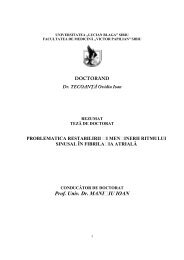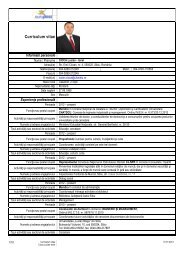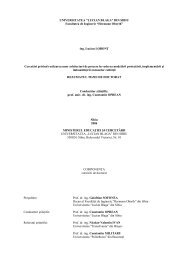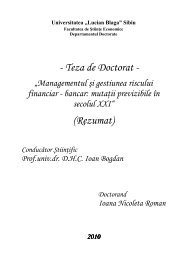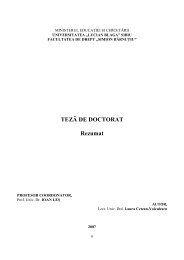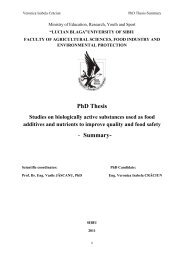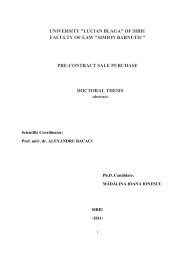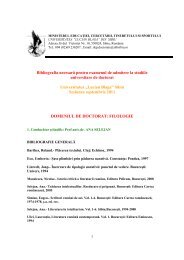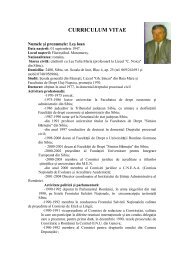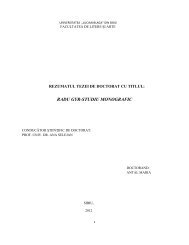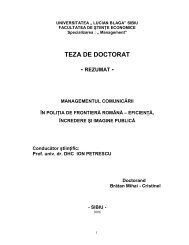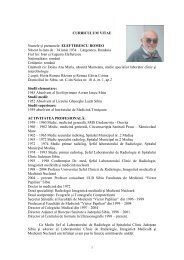Summary Keywords PhD Pricop Petru Ciprian - Doctorate ULBS
Summary Keywords PhD Pricop Petru Ciprian - Doctorate ULBS
Summary Keywords PhD Pricop Petru Ciprian - Doctorate ULBS
You also want an ePaper? Increase the reach of your titles
YUMPU automatically turns print PDFs into web optimized ePapers that Google loves.
SUMMARY<strong>Keywords</strong>: Holy Scripture, Old Testament, New Testament, patristic testimony, Filotei theMonk, Makarios the Hieromonk, psalms, Psalter, Psalter in lyrics, chosen psalms, polyeleos, Matin,Megalinaria, pripeli, veliceanii, argon, syntomon, chimes, scale, formula, modulation, melodics,ambitus, melodic-rhythmic formulas, text, translation, Tomul al II -lea al Antologhiei.The reason for choosing the theme, Singing of psalms in the Romanian Orthodox Church.Polyeleos in the creation of Makarios the Hieromonk, resides in the generic importance of the Psalmsfor Christian orthodox cult, in their multiple liturgical use, out of which I decided to bring in thereader’s attention the Polyeleos, as these are conveyed by the musical genius of Makarios theHieromonk (1770-1836).The existential relation between Romanians and Psalter is a legacy of the Christianetnogenesis of our nation, as the philosopher Constantin Noica shows: „I do not know if somewhereelse the Old Testament Psalms were read as much as we did. Anyway, to Romanian eternity that I amspeaking about is of this type. Not the historical plenitude, not the major accomplishments – that ourpeople would not have had time to fulfill – give the lasting warranty, but the feeling that, basically,there is a plan to which all historical kneading is wasted and loss. But – and here is the new aspectto biblical mourning – the Romanian people is, in a way, solidarity with that unchanging plan. It isgoing through many, it is fluttering for what is next to it, over it even – but it remains unchanged. ”Itwill go away” is one of the most commonly used Romanian saying. Our people remains because itparticipates as well, in its own way, to the being eternity” 1 . Practically, we can affirm, without anymeans to exaggerate, that the Romanian people/nation was born under the sign of psalm. The Psalterhas the most numerous Romanian translations, a fact that certifies our natural predilection towardsthis rich spiritual, liturgical and messianic source/spring. Consequently, the first two chapters of thepresent thesis are briefly dedicated to psalm origin, authors and practice for both the Old Testamentperiod and for the Church of Christ Cult, from the Pale-Christian period until today.Being a thesis in the field of church music, I considered choosing for research, under therigorous coordination of Pr. Prof. <strong>PhD</strong> Vasile Grăjdian, a special singing, with its origin in psalms:the Polyeleos. This musical-liturgics moment from the Matins of Great Feasts and of mostimportant saints, as well as of three Sundays form Triod Period - Polyeleos, makes the study objectof the present doctoral thesis, with emphasis on the means that it was cultivated by the great eruditeof the Romanian Orthodox Church, out of which we mention the Blessed Father Filotei, the Monk
from Cozia, the author of „pripeli” and Makarios the Hieromonk, the initiator of the “Romanization”of church singings.Makarios the Hieromonk, in his noble action of “Romanization” of the church singings,prints at Bucharest, in the year of 1827, the Second Tome of Antologhia, which comprises amongothers, a series of Polyeleos - creations belonging to noble Protopsalts (Jacob the Protopsalti, Joanthe Protopsalti, Daniil the Protopsalt, etc.,), that were translated into Romanian.Therefore, the following two chapters of the thesis are enshrined to polyeleos as part of Matinritual (chapter III) and especially to the multiple musical possibilities used by Makarios theHieromonk in Romanian writing of the Polyeleos of Tome II of Antologhia (Bucureşti, 1827 andBuzău, 1856).The present Thesis is structured as follows:Chapter I – General considerations regarding Psalms comprises: 1. Divine origin, authorsand writing time of psalms, as well as New Testament and Patristic testimonies regarding psalmssinging in the primary Church. 2. Translation and printing of Psalter for Romanians. 3. „Psalter inlyrics”.Chapter II – Psalms in the Orthodox Church cult meaning in the seven Praises, in the HolySacraments (Sfintele Taine), at the Holy Liturgy and at the Ierugas.Chapter III – Polyeleos form the Matin service comprises notions regarding the use of psalms44, 134, 135, and 136 in cult and of associated hymns: chosen psalms, mărimuri and pripeli.Chapter IV – Polyeleos translated by Makarios the Hieromonk and printed in Tome II of Anotologhia(Bucureşti 1827 and Buzău 1856) – on which we will focus exclusively, as well as on presentation ofbiographical data of certain composers of Polyeleos in argon (at large) style. Also here we arefocusing on „argon” and „syntomon” notions, as well as on 3 literary structures of all Polyeleosprinted by Makarios, following that at the end of each literary structure analyzed to present verse byverse the three forms of the liturgical text. The first two are: text in Greek language (the languagefrom which Hieromonk Makarios translated), Romanian text translated by Makarios -transliteration in Latin characters of the original text with Slavonic characters keeping the languagepeculiarities used by Makarios. The third form of liturgical text consists of the current version ofreligious text books. Parallel presentation is motivated by two aspects: on the one hand, as steadfastaspect, Polyeleos “Romanization”, in use before the nineteenth century, highlighting the weight ofthis melodic transformations, to which Father Makarios "was yoked", and on the other hand, as a
dynamic appearance, by observing the two Romanian texts, for an easier referral to languagedifferences, and, why not, for a future update of Polyeleos in a publication. At the end of each triplepresentation, the text will be included in a table, showing the number of syllables in each verse.This section also presumes musical analysis, with examples written in dual notation, ofPolyeleos employed in the cult of our Church.Thus, from the work “Tome II of Antologhia”, in terms of argon (at large) type Polyeleosargon, we selected Servants of the Lord Polyeleos – chimes I, making of John Protopsalti andthen, within syntomon (short), we intended to study: Chimes two diatonic Polyeleos, Chimes VIPolyeleos and Chime V Polyeleos. We will continue the musical analysis with Good wordPolyeleos - "making of Kyr Gheorghie Criteanul" – chimes Varis VII and the last, At the watersof Babylon - "making of Gregory Protopsalti" – chimes III (Ga as from Ni).In order to analyze the music, we have established a set of criteria that we considerrepresentative in this study. The first two criteria – Voice Scale and Formula (apechema) -graphical presentation of various scales in relation to analyzed Polyeleos, as well as of themelodic formula, always present in tuning. The third criterion - Modulations - we will analyzevarious modulators structures and, where possible, the entire modulator route. Penultimatecriterion - Melodic - is composed of: a) ambitus - graphical presentation of musical interval ofthe Polyeleos. In case of syntomon Polyeleos presented above, which are divided into two statesby the two psalms used, the whole analysis, and therefore the ambitus will be done in each stateseparately. As regards at large Polyeleos Servants of the Lord, Good word and At the waters ofBabylon, on the grounds that these use a psalm, the ambitus, as otherwise the whole analysis willbe unified. The following sub-criterion - b) - melodic-rhythmic formulas - will feature the samemelodic structure, various compositional procedures and, where appropriate, various variationaland imitative melodic structures; c) melodic climax area – through which we want to flaunt,especially through syntomon type Polyelos, “apotheosis” melodic track. The last criterion,Cadences – aspect that cannot be neglected in support of melodic tracks with and withoutmodulation, opportunity to indicate different cadence (non)modulating structures, theirvariational aspects, etc.. At the end of each presentation, cadences are summarized in tables,showing their type and number.This national-cultural work of Makarios is a titanic work especially in the givencircumstances of the times. Polyeleos translated and published in Bucharest in 1827 – Second
Tome of Antologhia is a golden page in the history of Romanian church music, the work andeffort being unprecedented.The thesis contribution consists in the following elements:1. The thesis beneficiates from a modern methodology under the coordination of Pr. Prof.<strong>PhD</strong>. Vasile Grăjdian.2. The theological subject is exciting.3. The scope of work is recognizable.4. The thesis is useful because it proposes the opening of a new perspective for research withvarious applications in the field of Practical Theology (Church, Liturgical Music, Typical).5. Research premises expose verifiable elements from the scientific point of view.6. The work gives birth to multidisciplinary connections by creating, starting from thesubject, of some leads of liturgical-musical, biblical-historic, linguistic and patristic research tracks.7. A large current bibliographical material was consulted (2007-2012).Priest <strong>PhD</strong> student <strong>Petru</strong> <strong>Ciprian</strong> <strong>Pricop</strong>



